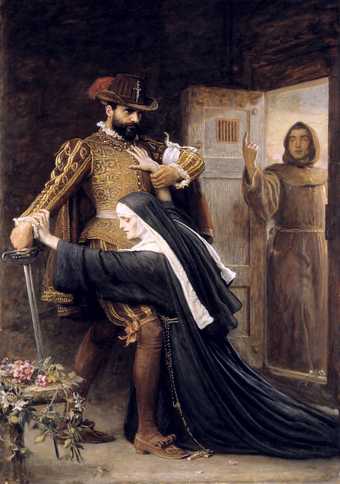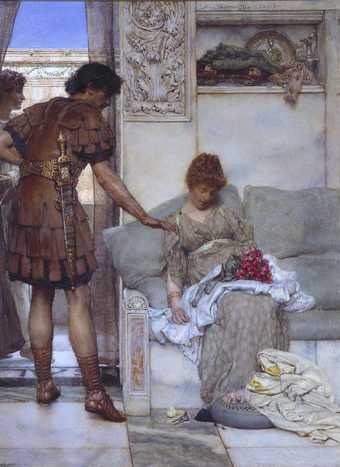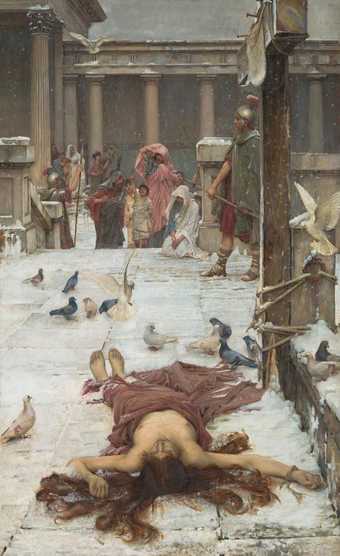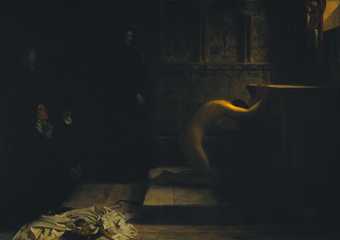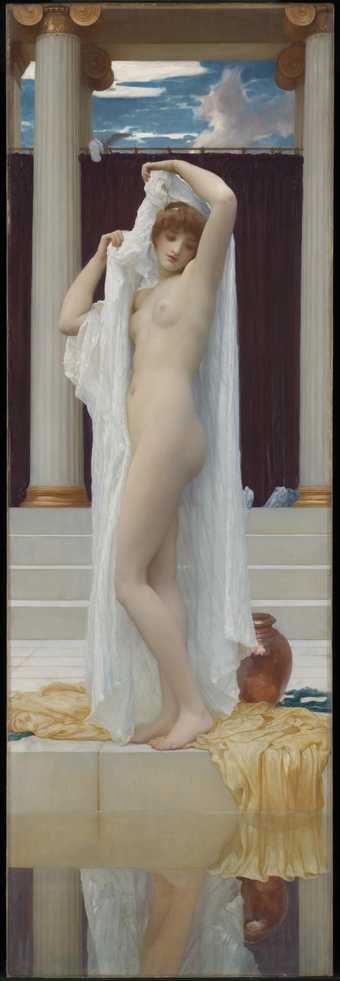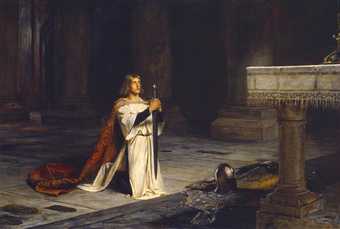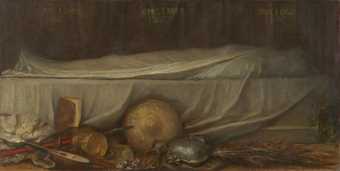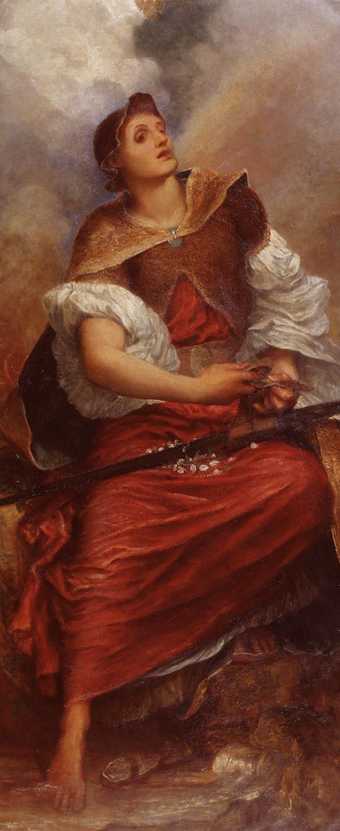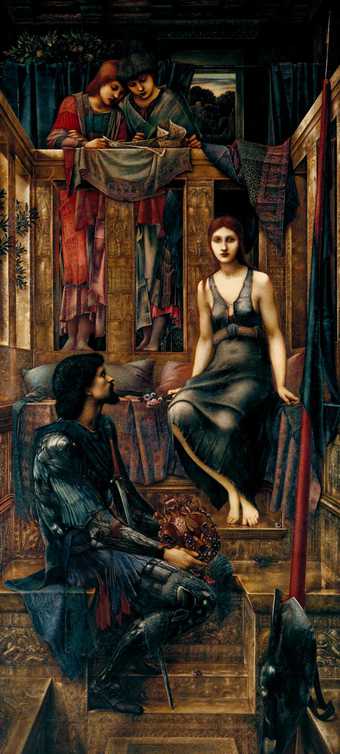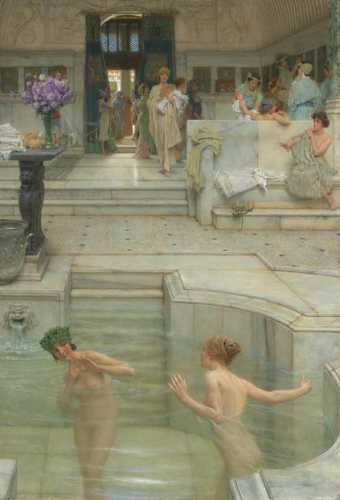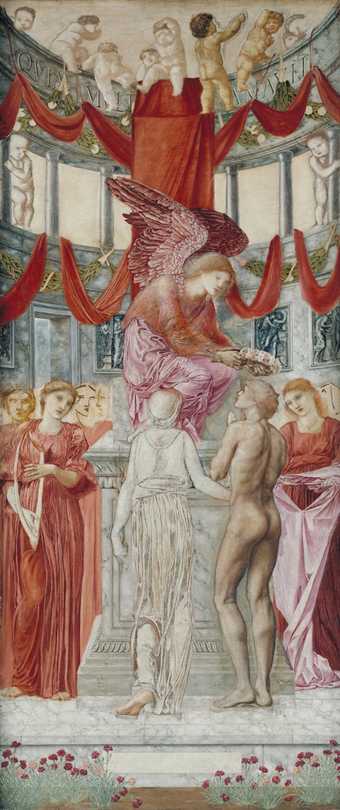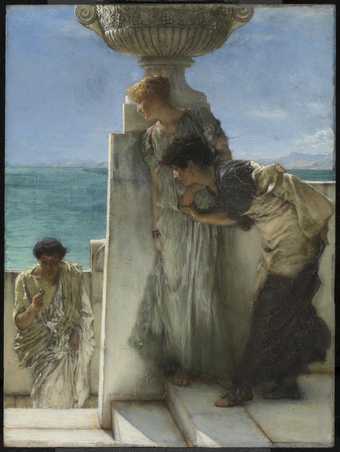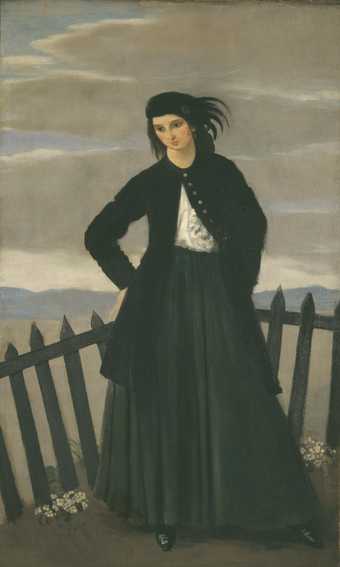
Not on display
- Artist
- Sir Lawrence Alma-Tadema 1836–1912
- Medium
- Oil paint on canvas
- Dimensions
- Support: 349 × 298 mm
- Collection
- Tate
- Acquisition
- Bequeathed by R.H. Williamson 1938
- Reference
- N04949
Summary
In Roman mythology, Apollo was the sun god who lived in Mount Olympus, and who, in the guise of the sun, rode his chariot drawn by four horses across the sky each day. In this painting one of the priestesses stands barefoot inside the temple of Apollo looking up towards the sky, perhaps awaiting Apollo’s return in the evening. She wears a spectacular leopard skin tunic, and has a wreath of ivy in her air. These symbolic ornaments, as well as her business in serving wine, suggest her licentious behaviour in the temple.
The subject matter is unusual for Alma-Tadema who, from the 1880s onwards, generally painted the ‘happy, inconsequential everyday incidents in the lives of anonymous though well-to-do inhabitants of Rome or Pompeii’ (Becker, p.11). Alma-Tadema had first travelled to Italy in 1863, visiting the ancient archaeological sites of Pompeii and Herculaneum. He revisited several times taking photographs of architectural details and artefacts which were used as reference material for his paintings when he returned to England. The golden jug that the priestess is holding and the large silver urn may have been amongst the recently excavated objects. The inclusion of the ‘latest archaeological discoveries enhanced the sense of immediacy, for spectators who would recognize the artefacts’ (Becker, p.36). Alma-Tadema’s 167 albums of photographs are now housed at the University of Birmingham.
At the time A Priestess of Apollo was painted, Alma-Tadema had risen to prominence in the London art world and had begun to entertain on a lavish scale at his large house in Grove End Road, St Johns Wood. He was knighted in 1899 and awarded the OM in 1907.
Further reading:
Christopher Wood, Olympian Dreamer: Victorian Classical Painters 1860-1914, London 1983
Edwin Becker, ed. Sir Lawrence Alma-Tadema, exhibition catalogue, Van Gogh Museum, Amsterdam 1997
R. J. Barrow, Lawrence Alma-Tadema, London 2001
Heather Birchall
February 2003
Does this text contain inaccurate information or language that you feel we should improve or change? We would like to hear from you.
Display caption
Apollo was one of the gods who lived on Mount Olympus. He was the sun god, and the Romans believed that he rode his fiery chariot drawn by four horses across the sky each day. Here, one of the priestesses of a Roman temple of Apollo looks rapturously upwards towards the sun. Alma-Tadema changed this picture extensively from his first design. The lines of a room now show through the thin paint of the walls to the left and right of the figure, and what is probably a marble bench is still visible to the immediate left of the figure.
Gallery label, September 2001
Does this text contain inaccurate information or language that you feel we should improve or change? We would like to hear from you.
Explore
- architecture(30,960)
- periods and styles(5,198)
-
- classical(1,040)
- clothing and personal items(5,879)
-
- fur(27)
- wreath(55)
- urn(52)
- actions: postures and motions(9,111)
-
- looking up(126)
- standing(3,106)
- woman(9,110)
- universal religious imagery(859)
-
- worship(65)
You might like
-
Sir John Everett Millais, Bt Mercy: St Bartholomew’s Day, 1572
1886 -
Sir Lawrence Alma-Tadema A Silent Greeting
1889 -
John William Waterhouse Saint Eulalia
exhibited 1885 -
Philip Hermogenes Calderon St Elizabeth of Hungary’s Great Act of Renunciation
1891 -
Frederic, Lord Leighton The Bath of Psyche
exhibited 1890 -
John Pettie The Vigil
exhibited 1884 -
George Frederic Watts The Minotaur
1885 -
George Frederic Watts Sic Transit
1891–2 -
George Frederic Watts Faith
c.1890–6 -
Sir Edward Coley Burne-Jones, Bt King Cophetua and the Beggar Maid
1884 -
Sir Lawrence Alma-Tadema A Favourite Custom
1909 -
Sir Edward Coley Burne-Jones, Bt The Temple of Love
date not known -
Sir Lawrence Alma-Tadema A Foregone Conclusion
1885 -
Sir Lawrence Alma-Tadema Sunday Morning
?1871 -
Augustus John OM Dorelia Standing before a Fence
c.1903–4

